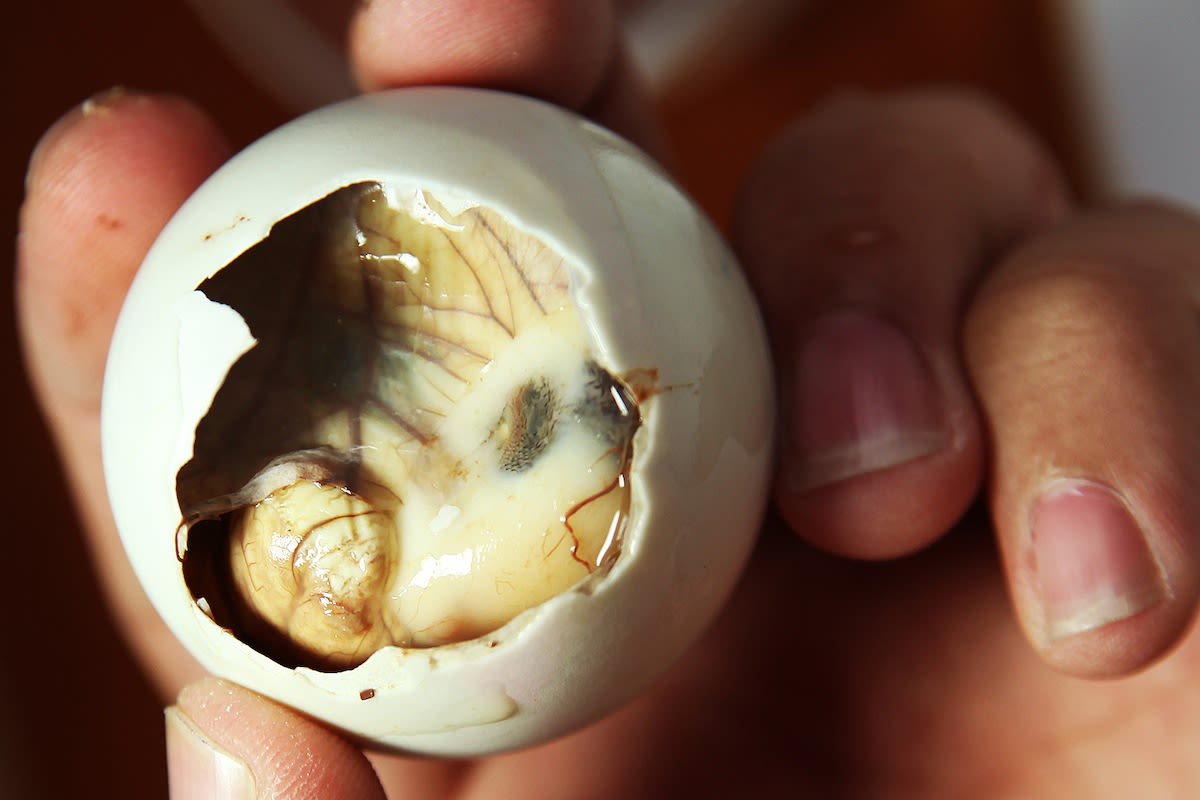
Balut is a unique and controversial delicacy enjoyed in the Philippines and other parts of Southeast Asia. This fertilized duck or chicken embryo, incubated for 14 to 21 days, is more than just a snack—it's a cultural icon. Balut has deep roots in Filipino traditions, often sold by street vendors near bustling markets and bus terminals. With its rich protein and calcium content, it’s also believed to have aphrodisiac properties and cognitive benefits. Despite its unusual appearance, balut continues to captivate food enthusiasts and curious eaters worldwide. Ready to learn more about this intriguing dish? Let's dive into 37 fascinating facts about balut!
Key Takeaways:
- Balut is a unique delicacy with a rich history and cultural significance in Southeast Asia, enjoyed as a snack and celebrated in festivals around the world.
- This fertilized duck or chicken embryo is not only a cultural symbol but also a nutritious snack, packed with essential nutrients and believed to have aphrodisiac properties.
What is Balut?
Balut is a unique and fascinating delicacy enjoyed in various parts of Southeast Asia. This fertilized duck or chicken embryo, incubated for a specific period, has a rich history and cultural significance.
-
Definition and Origin: Balut is a fertilized duck or chicken embryo incubated for 14 to 21 days. The term "balut" comes from the Filipino word for "wrapped," referring to the traditional incubation method.
-
Historical Background: The origins of balut trace back to China, where similar dishes like "maodan" have been consumed for centuries. Chinese traders introduced balut to the Philippines around 1565 or 1885.
Cultural Significance of Balut
Balut is more than just food; it holds a special place in the hearts and traditions of many Asian cultures.
-
Cultural Significance: In the Philippines, balut is a popular street food often associated with vendors near bus terminals and markets. It is also enjoyed in Vietnam, Cambodia, and other Asian countries.
-
Local Beliefs and Traditions: Filipinos believe the type of balut can be identified by placing it in water. If it floats, it's a "mamatong"; if it sinks, it's "balut na puti."
How is Balut Prepared?
The preparation of balut involves a meticulous process to ensure the embryo develops correctly and is safe to eat.
-
Preparation Process: Fertilized duck eggs are incubated at 40-42.5°C with high humidity for 14 to 18 days. Candling is used to monitor embryo development.
-
Types of Balut: There are two main types: "balut na puti" (wrapped in white) incubated for 18 days, and "mamatong" incubated for 16 days. The difference lies in embryo development.
Nutritional Value and Health Benefits
Balut is not only a cultural delicacy but also a nutritious snack packed with essential nutrients.
-
Nutritional Value: A single balut contains about 188 calories, 13.7 grams of protein, 14.2 grams of fat, 116 milligrams of calcium, and 2.1 milligrams of iron.
-
Aphrodisiac Properties: Some believe balut has aphrodisiac properties, especially for men, possibly due to its high protein content.
-
Health Benefits: Balut is thought to improve cognitive function and memory. Vendors often sell it outside colleges, believing it helps students perform better academically.
Safety and Consumption
Despite its benefits, balut must be handled and cooked properly to ensure safety.
-
Food Safety Guidelines: Balut is considered a "potentially hazardous food" due to Salmonella risk. It must be cooked to at least 74°C (165°F) for 15 seconds.
-
Eating Balut: Typically eaten directly from the shell after boiling or steaming. The liquid inside is sipped before consuming the rest.
Regional Variations and Festivals
Balut's popularity extends beyond the Philippines, with each region adding its unique twist to the delicacy.
-
Regional Variations: Balut is enjoyed in Vietnam (hot vit lon), Cambodia (phog tea khon), Laos, Thailand, Malaysia, and Indonesia, each with unique preparation methods.
-
Balut Festivals: Pateros in Metro Manila, known as the "Balut Capital," hosts annual balut festivals featuring music, dancing, cooking competitions, and plenty of balut.
Balut in Modern Times
Balut continues to evolve, finding its way into modern cuisine and media.
-
Balut Eating Contests: These contests have become popular events worldwide, with the first held in Manhattan, New York.
-
Balut in Media: Featured in shows like "Fear Factor" and "Survivor," balut often sparks controversy and fascination.
-
Balut in Modern Restaurants: Contemporary eateries now incorporate balut into their menus, showcasing its versatility and cultural significance.
Production and Quality
The quality of balut can vary based on the production methods and the diet of the ducks.
-
Balut Production: Large-scale producers can produce up to a thousand balut per day, though traditional methods may yield higher quality eggs.
-
Aquatic Foods for Ducks: Lakes and rivers provide aquatic foods that improve the quality of duck eggs for balut production.
-
Commercial Feeds vs. Aquatic Foods: Traditional balut makers claim that commercial feeds do not produce eggs of the same quality as those fed with aquatic foods.
Balut Around the World
Balut is known by different names and prepared uniquely in various countries.
-
China: Known as "maodan," it is a fertilized duck egg incubated for 14 to 16 days.
-
Vietnam: Called "hot vit lon," it is incubated for 19 to 21 days.
-
Cambodia: Known as "phog tea khon," it is incubated for 18 to 20 days.
-
Laos: Popular with its own unique preparation methods.
-
Thailand: A common snack in many parts of the country.
-
Malaysia: Known as "telur puyuh," it is a popular street food.
-
Indonesia: Often served as a snack in many regions.
Balut in Literature and Popular Culture
Balut has made its mark in literature and popular culture, further cementing its place in history.
-
Balut in Literature: Margaret Magat has written extensively about balut, highlighting its history and cultural significance.
-
Balut in Popular Culture: Featured in books, articles, and contests, balut's global exposure has popularized the dish.
Eating Balut as a Snack
Balut is often enjoyed as a snack, with various accompaniments enhancing its flavor.
-
Balut as a Snack: Commonly sold at street food stalls and markets, where it is boiled or steamed before serving.
-
Balut with Accompaniments: Typically eaten with salt, vinegar, soy sauce, pepper, and Vietnamese coriander, varying by region and preference.
Balut in Traditional Medicine
Some cultures believe balut has medicinal properties, though scientific evidence is lacking.
- Balut in Traditional Medicine: Thought to improve cognitive function and memory, though no scientific evidence supports these claims.
Balut Festivals Around the World
Balut festivals celebrate the cultural significance of this unique delicacy, bringing communities together.
- Balut Festivals Around the World: While Pateros in the Philippines is famous for its balut festivals, other regions also host similar events.
Techniques for Eating Balut
Eating balut requires a specific technique to fully enjoy the experience.
- Balut Eating Techniques: The liquid inside the egg is sipped from the shell before consuming the rest, a process known as "higop."
Historical Context of Balut
Balut has been a part of Filipino cuisine for centuries, influenced by cultural exchanges.
- Balut in Historical Context: Its historical significance is tied to Chinese traders and cultural exchanges between Asian countries.
Balut as a Symbol of Identity
For many, eating balut is a way to connect with their cultural heritage.
- Balut as a Symbol of Identity: Represents a link to roots and traditions for many Filipinos.
Balut in Modern Media
Balut's presence in media has raised awareness about this unique dish.
- Balut in Modern Media: Featured in TV shows and documentaries, helping to raise awareness about its cultural significance.
Traditional and Modern Production Methods
Balut production methods vary, with traditional methods often yielding higher quality eggs.
- Balut Production Methods: Traditional makers use specific methods to incubate eggs, ensuring proper development and safety.
Balut: A Culinary Adventure
Balut is more than just a snack; it's a cultural experience. This fertilized duck or chicken embryo, incubated for 14 to 21 days, has deep roots in Filipino culture and other parts of Southeast Asia. From its origins in China to its status as a street food staple, balut offers a rich tapestry of history and tradition. Packed with protein, calcium, and believed aphrodisiac properties, it’s both nutritious and intriguing. Despite safety concerns, proper preparation ensures it’s safe to eat. Whether you’re sipping the broth or savoring the embryo, eating balut connects you to a unique culinary heritage. Festivals, eating contests, and modern restaurant menus showcase its versatility. Balut remains a symbol of identity and tradition, bridging past and present in a single bite. Dive into this culinary adventure and discover the world of balut.
Frequently Asked Questions
Was this page helpful?
Our commitment to delivering trustworthy and engaging content is at the heart of what we do. Each fact on our site is contributed by real users like you, bringing a wealth of diverse insights and information. To ensure the highest standards of accuracy and reliability, our dedicated editors meticulously review each submission. This process guarantees that the facts we share are not only fascinating but also credible. Trust in our commitment to quality and authenticity as you explore and learn with us.


